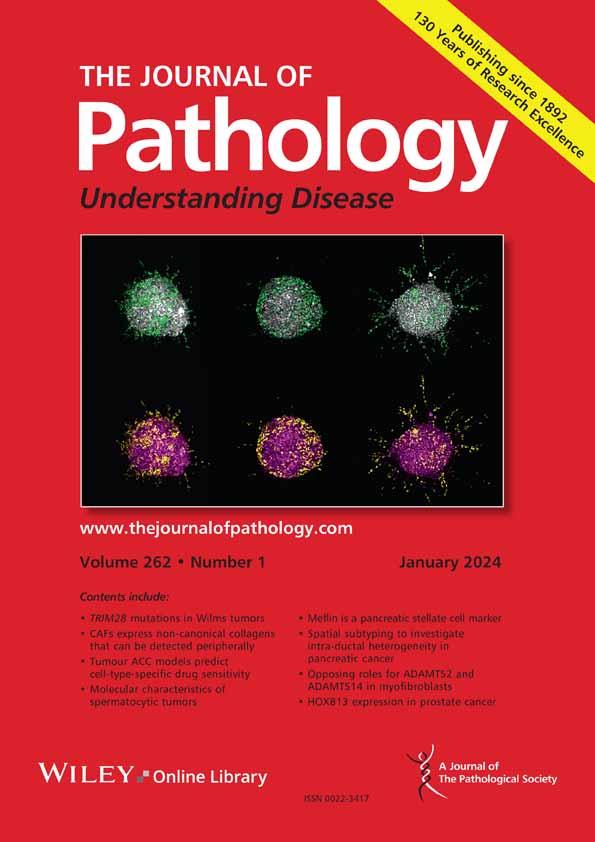Spencer D Martin, Shelby Thornton, Christine Chow, Katy Milne, Juliana Sobral de Barros, Kayleigh A Morris, Samuel Leung, Amy Jamieson, Brad H Nelson, Dawn R Cochrane, David G Huntsman, C Blake Gilks, Lien Hoang, Jessica N McAlpine, Allen W Zhang
下载PDF
{"title":"Activated immune infiltrates expand opportunities for targeted therapy in p53-abnormal endometrial carcinoma","authors":"Spencer D Martin, Shelby Thornton, Christine Chow, Katy Milne, Juliana Sobral de Barros, Kayleigh A Morris, Samuel Leung, Amy Jamieson, Brad H Nelson, Dawn R Cochrane, David G Huntsman, C Blake Gilks, Lien Hoang, Jessica N McAlpine, Allen W Zhang","doi":"10.1002/path.6429","DOIUrl":null,"url":null,"abstract":"<p>Tumor protein p53 mutated/abnormal (p53abn) endometrial carcinomas account for over 50% of deaths but comprise only 15% of all endometrial carcinomas. Most patients show limited response to standard-of-care chemotherapy with or without radiotherapy, and only a minority of cases are amenable to targeted therapies like poly-ADP ribose polymerase (PARP) inhibitors and HER2-directed therapies. Recent immunotherapy clinical trials have demonstrated remarkable efficacy, not only in mismatch repair deficient (MMRd) tumors but also in a subset of mismatch repair-proficient (MMRp) tumors. However, the immune microenvironment and its relationship to other therapeutic targets in MMRp endometrial carcinoma remains poorly understood. Here, we characterize the immune microenvironment of p53abn endometrial carcinoma, the most clinically aggressive subtype of MMRp endometrial carcinoma, and correlate antitumor immune signatures with other targetable alterations. We accrued 256 treatment-naïve p53abn endometrial carcinomas and systemically profiled T-cell, B-cell, myeloid, and tumor-cell populations with multiplex immunofluorescence to assess the tissue localization and functional status of immune cells. Shallow whole-genome sequencing was performed on a subset of 126 cases. Patterns of immune infiltration were compared to survival outcomes and mutational signatures. Mixture modeling divided p53abn endometrial carcinoma into tumor-infiltrating lymphocyte (TIL)-rich and TIL-poor subsets. Over 50% of tumors were TIL-rich. TIL-rich cases overexpressed targetable immune evasion molecules and were associated with longer overall and disease-specific survival in multivariate analysis. This effect was particularly pronounced in advanced stage disease and in patients who did not receive adjuvant chemotherapy. TIL did not associate with homologous recombination deficient mutational signatures or HER2 amplification. Our findings demonstrate a biological rationale for immunotherapy in a substantial subset of patients with p53abn endometrial cancer and may help inform combination therapies with immune checkpoint inhibition, PARP inhibitors, and anti-HER2 agents. © 2025 The Author(s). <i>The Journal of Pathology</i> published by John Wiley & Sons Ltd on behalf of The Pathological Society of Great Britain and Ireland.</p>","PeriodicalId":232,"journal":{"name":"The Journal of Pathology","volume":"266 3","pages":"292-305"},"PeriodicalIF":5.2000,"publicationDate":"2025-04-14","publicationTypes":"Journal Article","fieldsOfStudy":null,"isOpenAccess":false,"openAccessPdf":"https://onlinelibrary.wiley.com/doi/epdf/10.1002/path.6429","citationCount":"0","resultStr":null,"platform":"Semanticscholar","paperid":null,"PeriodicalName":"The Journal of Pathology","FirstCategoryId":"3","ListUrlMain":"https://pathsocjournals.onlinelibrary.wiley.com/doi/10.1002/path.6429","RegionNum":2,"RegionCategory":"医学","ArticlePicture":[],"TitleCN":null,"AbstractTextCN":null,"PMCID":null,"EPubDate":"","PubModel":"","JCR":"Q1","JCRName":"ONCOLOGY","Score":null,"Total":0}
引用次数: 0
引用
批量引用
Abstract
Tumor protein p53 mutated/abnormal (p53abn) endometrial carcinomas account for over 50% of deaths but comprise only 15% of all endometrial carcinomas. Most patients show limited response to standard-of-care chemotherapy with or without radiotherapy, and only a minority of cases are amenable to targeted therapies like poly-ADP ribose polymerase (PARP) inhibitors and HER2-directed therapies. Recent immunotherapy clinical trials have demonstrated remarkable efficacy, not only in mismatch repair deficient (MMRd) tumors but also in a subset of mismatch repair-proficient (MMRp) tumors. However, the immune microenvironment and its relationship to other therapeutic targets in MMRp endometrial carcinoma remains poorly understood. Here, we characterize the immune microenvironment of p53abn endometrial carcinoma, the most clinically aggressive subtype of MMRp endometrial carcinoma, and correlate antitumor immune signatures with other targetable alterations. We accrued 256 treatment-naïve p53abn endometrial carcinomas and systemically profiled T-cell, B-cell, myeloid, and tumor-cell populations with multiplex immunofluorescence to assess the tissue localization and functional status of immune cells. Shallow whole-genome sequencing was performed on a subset of 126 cases. Patterns of immune infiltration were compared to survival outcomes and mutational signatures. Mixture modeling divided p53abn endometrial carcinoma into tumor-infiltrating lymphocyte (TIL)-rich and TIL-poor subsets. Over 50% of tumors were TIL-rich. TIL-rich cases overexpressed targetable immune evasion molecules and were associated with longer overall and disease-specific survival in multivariate analysis. This effect was particularly pronounced in advanced stage disease and in patients who did not receive adjuvant chemotherapy. TIL did not associate with homologous recombination deficient mutational signatures or HER2 amplification. Our findings demonstrate a biological rationale for immunotherapy in a substantial subset of patients with p53abn endometrial cancer and may help inform combination therapies with immune checkpoint inhibition, PARP inhibitors, and anti-HER2 agents. © 2025 The Author(s). The Journal of Pathology published by John Wiley & Sons Ltd on behalf of The Pathological Society of Great Britain and Ireland.
激活的免疫浸润扩大了p53异常子宫内膜癌靶向治疗的机会。
肿瘤蛋白p53突变/异常(p53abn)子宫内膜癌占死亡人数的50%以上,但仅占所有子宫内膜癌的15%。大多数患者对标准治疗化疗(伴或不伴放疗)的反应有限,只有少数病例可接受靶向治疗,如多adp核糖聚合酶(PARP)抑制剂和her2靶向治疗。最近的免疫治疗临床试验不仅在错配修复缺陷(MMRd)肿瘤中,而且在错配修复精通(MMRp)肿瘤中也显示出显著的疗效。然而,免疫微环境及其与MMRp子宫内膜癌其他治疗靶点的关系仍然知之甚少。在这里,我们描述了p53abn子宫内膜癌的免疫微环境,MMRp子宫内膜癌中最具临床侵袭性的亚型,并将抗肿瘤免疫特征与其他可靶向的改变联系起来。我们收集了256例treatment-naïve p53abn子宫内膜癌,并用多重免疫荧光法对t细胞、b细胞、髓细胞和肿瘤细胞群进行了系统分析,以评估免疫细胞的组织定位和功能状态。对126例患者进行了浅全基因组测序。将免疫浸润模式与生存结果和突变特征进行比较。混合模型将p53abn子宫内膜癌分为肿瘤浸润淋巴细胞(TIL)丰富亚群和TIL缺乏亚群。超过50%的肿瘤富含til。在多变量分析中,富含til的病例过度表达可靶向的免疫逃避分子,并与更长的总体和疾病特异性生存相关。这种效果在晚期疾病和未接受辅助化疗的患者中尤为明显。TIL与同源重组缺陷突变特征或HER2扩增无关。我们的研究结果证明了免疫治疗在相当一部分p53abn子宫内膜癌患者中的生物学原理,并可能有助于告知免疫检查点抑制、PARP抑制剂和抗her2药物的联合治疗。©2025作者。《病理学杂志》由John Wiley & Sons Ltd代表大不列颠和爱尔兰病理学会出版。
本文章由计算机程序翻译,如有差异,请以英文原文为准。





 求助内容:
求助内容: 应助结果提醒方式:
应助结果提醒方式:


